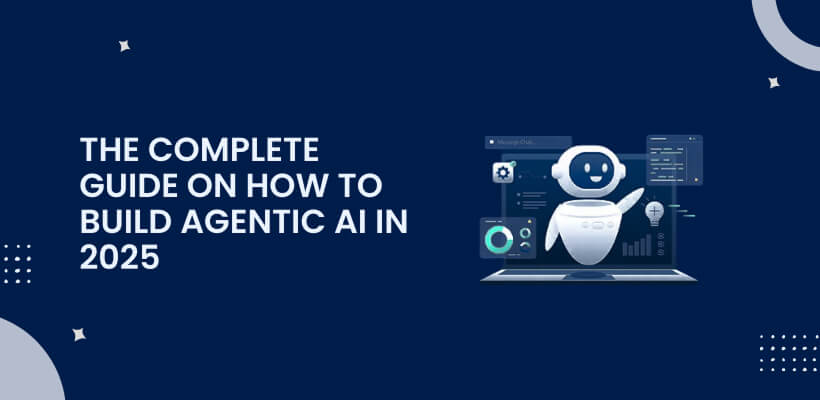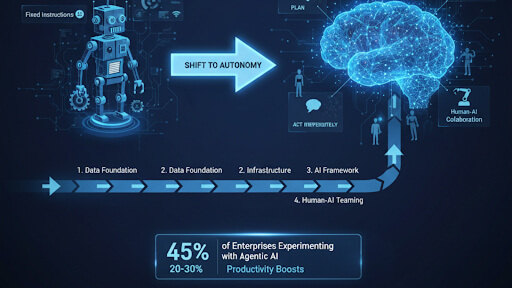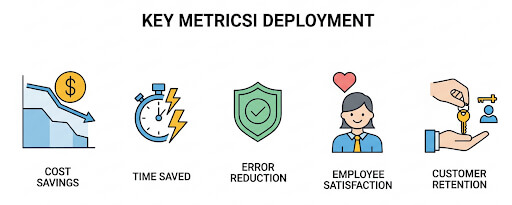 1-800-805-5783
1-800-805-5783 
Artificial intelligence is no longer about machines following fixed instructions. In 2025, the fundamental shift is toward agentic AI autonomous systems that can plan, reason, and act independently. Unlike traditional AI models that only respond to prompts, agentic AI agents make decisions, adapt to real-world changes, and collaborate with humans to solve problems.
If you’re asking how to build an agentic AI, you’re not alone. Gartner’s 2025 research shows that over 45% of enterprises are experimenting with agentic AI frameworks, and nearly every industry expects productivity boosts of 20–30%. However, building agentic AI requires more than just coding; it necessitates a roadmap that combines data, infrastructure, and people.
This guide breaks down what agentic AI is, why it matters, and how you can build it step-by-step.

Traditional AI systems are like calculators; they process inputs and give outputs. Agentic AI systems behave more like teammates. They analyze data, make decisions, and even take actions without waiting for explicit commands.
Key features that set agentic AI apart:
Dr. Elena Foster, AI Strategy Analyst at Deloitte, explains:
“Agentic AI is moving us from predictive models to proactive systems. Instead of just answering questions, these systems can actually take responsibility for parts of business operations.”
Global trends highlight why enterprises are investing heavily in agentic AI:
In short, building agentic AI is no longer optional; it has become a competitive necessity.
Before diving into coding, it is essential to understand the core components of an agentic AI system.
You need to define what your AI agent will achieve. Is it reducing fraud? Managing inventory? Improving customer support? Clear objectives shape the entire build process.
Agentic AI thrives on clean, structured, and real-time data. Poor data equals poor decisions. Integrate your CRM, ERP, IoT devices, and third-party APIs to streamline your operations and enhance efficiency.
This is where the agent plans and decides. Modern frameworks use LLMs (large language models) with planning and reasoning layers (like LangChain or AutoGPT).
The system must take action, such as sending emails, updating databases, triggering workflows, or interacting with APIs.
Agents need feedback to improve. Logging actions, monitoring outcomes, and retraining ensure they don’t repeat mistakes.
Review the existing data, including customer records, financial transactions, and sensor data, to inform your analysis. Then clean and structure it. In 2024, 80% of AI failures were linked to insufficient data.
In 2025, the most common frameworks include:
Pick based on your use case.
Don’t build a generalist. Create a specialist. Examples:
Combine LLMs with tools like vector databases for memory and APIs for real-time execution. Example workflow:
Connect your agent to ERP, CRM, or HR tools. Without integration, it stays theoretical.
Start small by deploying agentic AI in one department, such as claims processing or demand forecasting: track ROI, speed gains, and error reductions to prove its value. Gather employee feedback to identify gaps and test data quality and integrations. A pilot acts as proof of value and a learning phase, giving you confidence to scale AI across more functions.
After the pilot shows precise results, expand AI agents into other areas such as logistics, procurement, or customer support. Scaling should be gradual, ensuring each function integrates smoothly with existing systems. Although agentic AI operates autonomously, continuous monitoring remains essential.
Track agent decisions, validate accuracy, and ensure compliance with regulations. Regular oversight fosters trust, prevents errors, and ensures performance remains aligned with business goals. Treat scaling as an iterative process: test, refine, and then broaden deployment.
Here are real-world scenarios to inspire your build:
According to the 2025 Tech Outlook:
“By 2027, companies that integrate agentic AI into workflows will outperform competitors by 35% in profitability and innovation.”
This aligns with what you see in 2025: early adopters are already pulling ahead.

When you deploy agentic AI, track metrics such as:
Learning how to build agentic AI in 2025 involves combining clean data, intelligent frameworks, and human oversight. Done right, AI agents won’t just automate; they’ll transform how you run operations. The companies that adopt today won’t just save money; they’ll lead industries tomorrow.
1. What is agentic AI?
Agentic AI is a system that acts independently to achieve goals, using reasoning, planning, and action execution.
2. How to build agentic AI for my business?
Start by defining clear goals, auditing data, picking the proper framework, and testing with a pilot project.
3. Which industries use agentic AI?
Banking, supply chain, retail, HR, and healthcare lead adoption in 2025.
4. Is agentic AI safe?
Yes, when monitored correctly. Oversight prevents errors and ensures compliance.
5. How much does it cost to build agentic AI?
Small pilots start under $100k. Enterprise-wide rollouts scale into millions, depending on complexity.
At [x]cube LABS, we craft intelligent AI agents that seamlessly integrate with your systems, enhancing efficiency and innovation:
Integrate our Agentic AI solutions to automate tasks, derive actionable insights, and deliver superior customer experiences effortlessly within your existing workflows.
For more information and to schedule a FREE demo, check out all our ready-to-deploy agents here.